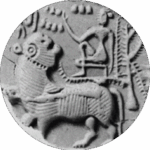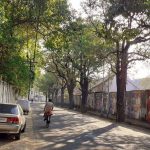Enjoying Cochin
I arrived on Monday morning in Kochi, a direct flight on Arkia. The plane was full of middle-aged to elderly Israeli tourists, many of whom appeared to be part of organized tour groups. A few young people; two or three Malayalis returning home. But it was an easy flight. Arkia, unlike what seems to have been the arrangement a few months ago, took a route that skirted Saudia Arabia, heading down the Red Sea as far as Djibouti, then turning east. So it was longer than in could have been. But since it was a night flight, it didn’t make any difference. While on the plane and waiting for departure, I booked a room in a guest house. Although this wasn’t necessary, I think it makes a better impression with the immigration people if one has an address to give upon arrival. The room wasn’t great; full of mosquitoes, and cockroaches emerging from the bathroom grate at night. By the second day I found something more suitable, though still inexpensive.
In Fort Kochi this is at about the end of the tourist season. Southern India is beginning to heat up. I was once here in August, during the monsoon time, and it was more pleasant. But early morning and from about 4 PM the temperatures are fine. Today, I went out at lunch time, intending to visit the nearby Indo-Portuguese museum, but finding it closed, took a longer walk, shaded by my umbrella. The latter I bought in Kumily last year, but it was made in Aleppy, not far from here. As Dorab says, in India it’s always a good idea to carry an umbrella, because it is good against both the rain and the sun. And Indian umbrellas usually have a silver underlining against the rays of the sun.
I walked along the road that goes down by the ferry port, hoping to find a small cafe I had remembered from my earlier visit, but it seems to have gone. I found another, the Los Angeles cafe, which, despite its name, was very nice. I had a vegetable thali (supposedly a complete meal tray) and a glass of lemon iced tea. It was a tourist style variation on a thali, really – with papad, pickle, sabji and a whole grain, but quite good and nourishing. Here in Kochi the main speciality is fish and shellfish, but these are off the menu for me. It’s quite easy to be a vegetarian and now even a vegan however. Trying to be completely vegan is something I have not bothered with much in India. But here, besides the traditional vegan options, many restaurants offer more eclectic vegan portions and desserts. And I’ve discovered two entirely vegan restaurants so far.
Along the road by the ferry, there are many old homes with courtyards overlooking the sea, or rather the inlet between the mainland and the island. I snapped a couple of photos of these along the way home, as well as some of the graffiti on the walls siding the streets.
The Guardian today has one of its Long Read articles about India, “How Hindu Supremacists are tearing India apart”, which seems to give a good account of the troubling slide in secularism that worries everyone not subscribing to the ideology of the BJP. But so many quite ordinary people do. Just as in Israel, in the UK, in Italy, the US, and so many other places, inquiring into the views of one’s neighbors can be very disappointing. As the article points out, the danger in India, may be still greater than these other places, given the country’s existing propensities for civil unrest and its shaky union between so many disparate cultures, languages, religions, castes and ethnicities. The Muslim minority in India constitutes 180 million people.
While here I have been reading some of the writings of Paul Bowles, who I only recently discovered. “The Sheltering Sky”, his writings on travel, and now “The Spider’s House”. He’s an intriguing writer, with a fascinating life story. He was acquainted with some of the significant writers, musicians and artists of the 20th century. It was Gertrude Stein who persuaded him to go live in Tangiers, where he settled and lived for decades. I read a little of his travels here in Kerala today. What a different style of travel from today! He carried with him eighteen suitcases. He describes how at a border check between two Indian states, the customs officers were concerned that he was planning to sell clothing. “Why would I want to sell my clothes?” he asked them.
I think that the kind of travel writing that he describes has completely gone by the wayside today, and perhaps some people would say, good riddance. Especially that of white people discovering Africa and India. Amitav Ghosh’s book, “In an Antique Land”, was perhaps more interesting; a post-colonial traveler whom the “natives” (Egyptian villagers) saw as coming from a still more backward place (India). But that book too was published almost thirty years ago.
Bowles is a sensitive traveler. His novels are very well written, and obviously distance themselves from the views of their sometimes racist protagonists. To what extent, Bowles’ own views might be out of date, I’m not sure yet. Certainly, all writers are a product of their times; and earlier times usually equates to less enlightened than our own (though sometimes we’re proved wrong about that. But amusingly, it’s much easier to pick out the imperfections of earlier times, and much harder to notice the flaws in the mannerisms and ways of thinking of our own times. I’ve lived long enough to know that much.

